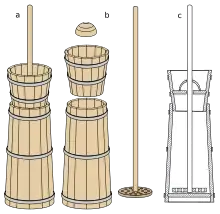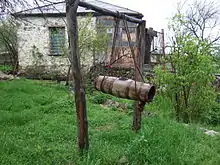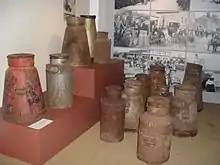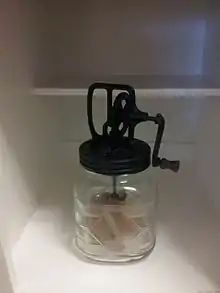Butter churn
A butter churn is a device used to convert cream into butter. This is done through a mechanical process, frequently via a pole inserted through the lid of the churn, or via a crank used to turn a rotating device inside the churn.



Etymology
The word “butter” is believed to be derived from the Greek word bou-tyron, the approximate meaning of which is “cow cheese”. However, some believe the word came from the Scythian culture, as the ancient Greeks tended to herd sheep and goats, whose milk is not as good for butter making as that of cows, which the Scythians primarily herded.[1] The word "churn" is from the Old English ċyrin, to churn. This is probably derived from the Old English cyrnel, "kernel," due to the appearance of butter grains after milk has been churned.[2]
The butter churn gave its name to the milk churn, early examples of which were based on butter churns. The milk churn is not, however, used for the act of churning, but rather to transport milk.
History
Evidence for the use of butter dates back as early as 2000 BC,[3] and there is mention of it in biblical works. The butter churn itself may have existed as early as the 6th century AD, as can be seen by what appears to be a churn lid dating from that era.[4] In the European tradition, the butter churn was primarily a device used by women, and the churning of butter was an essential responsibility along with other household chores.[5] In earlier traditions of butter making, nomadic cultures placed milk in skin bags and produced butter either by shaking the bag manually, or possibly by attaching the bag to a pack animal, and producing butter simply through the movement of the animal. Some theorists believe this is how the butter creation process was discovered. Some cultures still use a process similar to this, whereby a bag is filled with milk, tied to a stick, and vigorously shaken.
Types of butter churns


The most historically prominent types of butter churns are the plunge churn, which is a container, usually made out of wood, where the butter-making action is created by moving in a vertical motion a staff that is inserted into the top. This type of churn is also known as an ‘up and down’ churn, churning tub, plunger churn, plumping churn, knocker churn, plump-kirn, or plowt-kirn (where “kirn" is a Scots/Northern English word for churn). The staff used in the churn is known as the dash, dasher-staff, churn-staff, churning-stick, plunger, plumper, or kirn-staff.[6]
Another prominent type of churn was the paddle churn, which was a container that contained a paddle, which was operated by a handle. The paddle churned the butter inside the container when the handle was turned.


The barrel churn was also used extensively. This type of churn was a barrel turned onto its side with a crank attached. The crank either turned a paddle device inside the churn, as in the paddle churn, or turned the whole barrel either horizontally or vertically, depending on its construction. Agitation of the cream in this manner converted the milk to butter. The barrel churn was one of the agricultural innovations of 18th century Europe.[7]
One particularly novel invention of note was the rocking chair butter churn. This device, invented by Alfred Clark, consisted of a barrel attached to a rocking chair. While the rocking chair moved, the barrel moved and churned the milk within into butter.[8]
See also
- Butter-churn tower, named after its similarity to a type of butter churn.
References
- Douma, Michael. Butter through the Ages. 2008. Institute for Dynamic Educational Development. http://www.webexhibits.org/butter
- "churn, n." The Oxford English Dictionary. 2nd ed. 1989. OED Online. Oxford University Press.
- Columbia Electronic Encyclopedia, 6th Edition. 2009 pg:1 -1. “Butter.”
- National Museums of Scotland, “Churn Lid.” http://nms.scran.ac.uk/database/record.php?usi=000-100-103-159-C
- Jensen, Joan M. What's in a Butter Churn? Objects and Women's Oral History. 1983. https://www.jstor.org/stable/3345974
- “Old and Interesting” http://www.oldandinteresting.com/history-butter-churns.aspx
- Ellis: Butter and Cheese, Soil And Health Library
- Sabin, L. “What a Wild Idea.” Boys’ Life, Sep 1990. 80.1, p 32.
External links
| Wikimedia Commons has media related to Butter churns. |
.JPG.webp)